Makeup as Protest: History in Liner and Lipstick
Explore the history of makeup protest from suffragettes to today. Red lips, bare skin, and bold liner become political beauty visuals that speak truth.
16 Jul'25
By Niharika Paswan


Makeup as Protest: History in Liner and Lipstick
Protest doesn’t always carry a sign. Sometimes, it wears eyeliner. Or a red lip. Or a bare, defiant face that refuses to cover anything up. While makeup is often dismissed as superficial, the truth is it’s never just been about looking pretty. From suffragettes to drag queens to social justice creators, makeup has always carried a message. A mirror. A refusal. A reclaiming.
To understand the power of beauty in protest, we have to go back. Because this isn't a new idea. This is legacy etched in rouge, smeared in pigment, painted with purpose.
Let’s trace the history of makeup protest, and why lipstick still says more than words ever could.
The Suffragette Red Lip

In the early 1900s, British and American suffragettes weren’t just fighting for the vote. They were also fighting for visibility. And one of their quiet weapons? Lipstick.
At a time when red lips were considered vulgar, reserved for actresses, sex workers, or social outliers wearing it in public became an act of defiance. It said, “You will look at me. You will hear me.” It turned heads not for vanity, but for power.
Elizabeth Arden famously handed out tubes of red lipstick to women marching for the vote in New York. It wasn’t about beauty standards. It was about using the language of beauty to reject silence.
In that moment, the red lip became protest. Not against men. Against invisibility. Mindy Gledhill shares this powerful moment in beauty history on Instagram, reminding us how a simple swipe of color once carried the weight of a movement.
The 70s: Bare Skin, Bold Stance

The feminist movements of the 1970s created a different kind of beauty backlash. As women questioned patriarchal beauty norms, many chose to reject makeup altogether. Going bare-faced wasn’t about not caring it was about making a statement.
In a world that expected women to decorate themselves for others, choosing not to wear makeup was revolutionary. It said: I don’t exist for your gaze.
But even within that, nuance existed. Some feminists continued to use makeup but on their own terms. Experimental eye looks, mismatched lipstick, clashing palettes nothing about it was pretty. It was all intentional disruption.
Makeup here became a tool to mock the system. To twist the rules. To make femininity unruly.
Queer Beauty and Drag as Political Performance
No conversation about political beauty visuals is complete without drag culture. Long before drag made it to mainstream media, it existed underground as survival, celebration, and protest.
Drag artists didn’t just wear makeup. They weaponized it.
Contouring became a kind of armor. Glitter, a light you couldn’t dim. Lashes longer than approval. Lips overdrawn until they couldn’t be ignored.
Every face beat in drag was a confrontation against binaries, against erasure, against shame.
And it continues today. In the face of rising anti-LGBTQ+ rhetoric, queer creators use makeup to say: I will not shrink. I will not disappear. I will take up digital space with everything you told me to hide. Sanny Dragon dives into the story behind the red lip movement in her vlog.
Red Lip Revivals and Cultural Backlash

The red lip keeps returning. In protests across the world from Poland’s abortion rights marches to Black Lives Matter rallies, lipstick remains a common thread. Especially red.
Why? Because it’s bold. It’s historic. And it never whispers.
But with every bold face comes backlash. Women in hijabs wearing red lipstick are called immodest. Queer creators with bright makeup are labeled "too much." Brown-skinned creators with graphic liner are told they look “aggressive.” The line between self-expression and social acceptability is still policed especially for those who don’t fit into Eurocentric standards of beauty.
That’s why makeup as protest remains powerful. Because the act of showing up unapologetically is still political. As one blog on Medium highlights, red lipstick has never been just about color it’s always carried meaning.
Admigos Builds Timelines into Face Stories
At Admigos, we believe faces carry history. Not just trends, but timelines. That’s why when we animate creator looks or beauty reels, we don’t just focus on the final frame we honor the full journey.
When a creator’s red lip is a nod to their grandmother’s revolution era, we animate that context. When a graphic liner recalls protest art from their hometown, we let that design echo visually. When a creator’s bare skin speaks louder than pigment, we keep the edit quiet on purpose.
Every edit is shaped by story. And protest, when woven into beauty, becomes a story worth lingering on. We animate with care, so the message doesn’t get lost in the motion.
Because for some, makeup isn’t just expression. It’s resistance, worn one layer at a time.
Final Thought: Liner, Lipstick, and Liberation
We live in a time where beauty is more visible than ever. But visibility doesn’t always mean freedom. That’s why the fight continues not just in streets and speeches, but on screens, mirrors, and faces.
From suffragettes to present-day creators, makeup has helped people show up for themselves, for their communities, for causes that demand attention.
It’s more than a look. It’s a stance.
So the next time you see a bold wing, a loud lip, a bare skin reel know that it might be saying more than you think. Beauty isn’t always soft. Sometimes, it shouts.
— By Niharika Paswan
Queer Creators on Beauty as Protest
A bold journey through Pride palettes, hyper-glam looks, and creator-led artistry that redefines beauty as resistance—celebrating queer identity, joy, and refusal through makeup.

What Really Makes a Formula Clean?
What really makes a formula clean? Explore the truth behind clean vs natural, marketing vs safety, and how clean beauty animation builds ingredient transparency.
